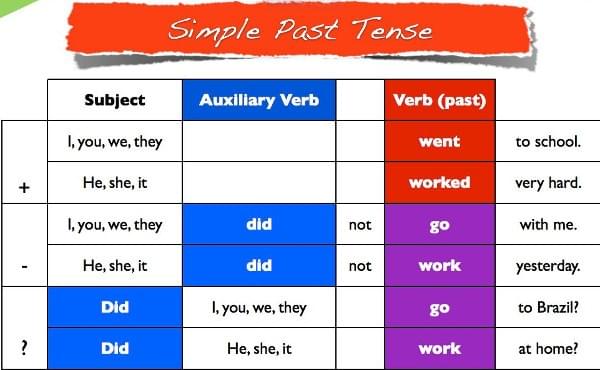- 1. Cách chia thì động từ IELTS Writing Task 1
- 2. Ngôn ngữ dự đoán tương lai Writing Task 1
- 3. Ngôn ngữ miêu tả xu hướng thay đổi
- 1. (Time period) + Subject + Verb to describe change + Adverb to describe the degree/ the speed of change.
- 2. (Time period) + “There” to introduce the subject + article + Adjective to describe the degree/ speed of change + Noun to describe change + in “what”
- Một số lưu ý Bạn cần ghi nhớ:
- Dàn bài gợi ý cho IELTS Writing Task 1
1. Cách chia thì động từ IELTS Writing Task 1
Việc chia đúng thì động từ trong phần thi IELTS Writing Task 1 là cực kì quan trọng. Để chia đúng thì, Bạn phải tìm hiểu trong phần tiêu đề câu hỏi và các thông tin liên quan đến thời gian trong các biểu đồ.
Ví dụ:
Nếu là một thời điểm tại quá khứ, ví dụ July 1997, Bạn sẽ sử dụng Past tenses.
>>> I met my husband in July 1997.
Nếu là dự đoán cho tương lai, ví dụ cho năm 2022, Bạn sẽ sử dụng Future tenses.
>>> Qatar will host the World Cup in 2022.
Nếu không có bất kỳ dấu hiệu nào về thời gian, Bạn hãy sử dụng Present tenses.
>>> Vietnam is a pretty awesome country.
1.1 Present simple - Hiện tại đơn
*** Present simple - Hiện tại đơn
- Diễn đạt một thói quen hoặc hành động lặp đi lặp lại trong hiện tại
- Chân lý, sự thật hiển nhiên
*** WHEN??? Bạn NÊN sử dụng thì Hiện tại đơn nếu đề bài không đề cập đến bất kỳ một mốc thời gian nào.
- IELTS Writing Task 1 Process – Quy trình có thể coi là Facts (sự thật) nên Present Simple là thì thích hợp nhất.
Ví dụ: In the leather production process, right after animal skin is soaked into water, it is then dried under high temperature.
- IELTS Writing Task 1 – Câu mở đầu (Paraphrase) và Câu nhận xét chung (Overview) Bạn đều sẽ chia ở thì hiện tại đơn.
>>> Ví dụ: The graph represents, chứ không phải là represented, hoặc It is immediately obvious that, không phải là it was immediately…

1.2 Present Perfect - Hiện tại hoàn thành
*** Present Perfect - Hiện tại hoàn thành
- Diễn tả sự việc diễn ra trong quá khứ kéo dài đến hiện tại
- Diễn tả hành động mới diễn ra gần đây
- Diễn tả sự trải nghiệm hay kinh nghiệm
S + have/ has + V3/ed
S + haven’t/ hasn’t + V3/ed
Have/ Has + S + V3/ed?
*** Trong IELTS Writing Task 1, Bạn sẽ sử dụng thì Hiện tại hoàn thành để nói về những thay đổi diễn ra qua một thời kì. Đặc biệt, thì này được dùng rất nhiều trong bài thi viết,
>>> Ví dụ: The price of oil has fallen by $5 a barrel every week since July.

1. 3 Present Perfect Continuous - Hiện tại hoàn thành tiếp diễn
*** Present Perfect Continuous - Hiện tại hoàn thành tiếp diễn:
- Diễn tả một hành động bắt đầu trong quá khứ diễn ra liên tục và kéo dài đến hiện tại
- Diễn tả hành động đã xảy ra, vừa mới kết thúc nhưng kết quả của hành động vẫn có thể nhìn thấy được ở hiện tại.
S + have/ has + been + V-ing
S + haven’t/ hasn’t + been + V-ing
Have/ Has + S + been + V-ing?
>>> Ví dụ: Oil prices have been decreasing since July.

1.4 Future Perfect - Tương lai hoàn thành
*** Future Perfect - Tương lai hoàn thành: Diễn tả sự việc sẽ kết thúc tại một thời điểm nào đó trong tương lai. Bạn sẽ sử dụng giới từ BY và IN khi viết câu với thì này, cũng như mẫu câu mẫu câu “A is predicted/projected to …”
*** IELTS Task 1 biểu đồ – vì các số liệu là phỏng đoán nên không thể dùng thì tương lai đơn để khẳng định các số liệu trong bài được.
Ví dụ:
- The price of oil will have reached $300 a barrel by 2020.
- As can be seen from the current trend, the number of travelers visiting Europe countries is predicted to further increase in the upcoming years.

1.5 Past simple - Quá khứ đơn
Past Simple - Quá khứ đơn được sử dụng để miêu tả sự việc bắt đầu và kết thúc tại các thời điểm trong quá khứ.
*** IELTS Writing Task 1 Dạng bài Biểu đồ và Maps thì đề bài sẽ có chu kỳ thời gian rõ ràng, thường là thời gian trong quá khứ. Như vậy, Bạn sẽ phải chia thì ở quá khứ đơn.
Ví dụ:
- The price of oil fell from $150 in Jan 2014 to $50 in Jan 2015.
- In 1994, while the amount of money spent on vehicles soared to reach the peak of $10 million, other expenditures for the rest decreased considerably by only $ 4 million.


1.6 Past Perfect - Quá khứ hoàn thành
*** Past Perfect - Quá khứ hoàn thành diễn tả sự việc xảy ra trước một sự việc khác xảy ra trong quá khứ.
>>> Ví dụ: After it had reached a peak of almost £70,000 in 1998, the average price dropped slightly in 2006 before finishing the period at £50,000 in 2000.


Ví dụ: The graphs below show a prediction to 2018 by the International Monetary Fund of the world’s Gross Domestic Product (GDP) growth.

- Sử dụng thì quá khứ đơn (Past Simple) để miêu tả yếu tố đã hoàn thành:
Ví dụ: In 2009 GDP dropped to -2.5%, the lowest growth across the period.
b. Sử dụng thì hiện tại hoàn thành (Present Perfect) để miêu tả yếu tố đã kết thúc nhưng mới xảy ra gần đây:
Ví dụ: GDP has increased from 1.6% in 2013 to 2.6% in 2014.
c. Sử dụng thì tương lai để dự đoán xu hướng:
Ví dụ: IMF predicts that there will be only small changes to GDP from 2015 to 2018.
2. Ngôn ngữ dự đoán tương lai Writing Task 1
Cấu trúc dự đoán tương lại thường được sử dụng trong IELTS Writing Task 1 vì vậy Bạn cần một số từ vựng và cấu trúc để miêu tả dự đoán.
- Tư vựng dự đoán tương lai:
- Verbs: predict, expect, forecast, anticipate, project, etc.
- Nouns: prediction, forecast, projection, etc.
- Cấu trúc dự đoán tương lai:
1/ Subject + will + Verb + Object + preposition + time.
Ví dụ: The city will construct a new civic center by 2020.
2/ According to current + Object (plural), there will be + Subject + preposition + time.
Ví dụ: According to current predictions, there will be a new civic center in the city by 2020.
3/ According to current + Object (plural), Subject + will + Verb + preposition + time.
Ví dụ: According to current predictions, the city will build a new civic center by 2020.
4/ It is + past participle + that + Subject + will + Verb + Object + preposition + time.
( It is predicted/forecast/expected/suggested/likely that)
Ví dụ: It is predicted that the city will construct a new civic center by 2020.
5/ Subject + is/are + past participle + to + Verb ( infinitive) + preposition + time.
(… is expected/forecasted/predicted)
Ví dụ: The proportion of the world's population is expected to double between 2016 and 2020.
6/ Subject + is/are + likely + to + Verb ( infinitive) + preposition + time.
Ví dụ: The proportion of the world's population is likely to double between 2016 and 2020.
Ví dụ:
The graph below shows the proportion of the population aged 65 and over between 1940 and 2040 in three different countries.
Summarize the information by selecting and reporting the main features, and make comparison where relevant.
Write at least 150 words.

Answer:
1. Since 2000, Swedish population is predicted to be older than American population and probably continue to increase in the next 40 years. However, the proportion of older people in Japan is predicted to dramatically rise from 2030, and Japanese population will become the oldest among 3 countries in the late 2030. In 2040, it is thought that the proportion of the population aged 65 and more in these countries will be similar at around 25%.
2. From 2000, it is predicted that Swedish population will become older than American, and Japanese aged population will suddenly boom and will become oldest among 3 countries. In 2040, people aged 65 and over accounted for a quarter of total population in 3 countries.
3. Ngôn ngữ miêu tả xu hướng thay đổi
*** Trong IELTS Writing Task 1, Bạn thường được yêu cầu miêu tả biểu đồ có sự thay đổi qua thời gian, Bạn cần sử dụng một số cấu trúc để diễn đạt tốt những xu hướng này.
>>> Đặc điểm nhận biết dạng bài có xu hướng thay đổi:
- Biểu đồ có ít nhất hai mốc thời gian
- Cần miêu tả những thay đổi chính
- Kết hợp với sự so sánh các mốc thời gian với nhau
- Số liệu thường được cung cấp dưới dạng đơn vị hoặc dưới dạng phần trăm.
*** Có Ba xu hướng thay đổi cơ bản: UP - DOWN - REMAIN, thường thể hiện trong một số đề bài về dân số, khối lượng sản xuất, thất nghiệp.
1. (Time period) + Subject + Verb to describe change + Adverb to describe the degree/ the speed of change.
Ví dụ: Between May and October, sales decreased slightly.
2. (Time period) + “There” to introduce the subject + article + Adjective to describe the degree/ speed of change + Noun to describe change + in “what”
Ví dụ: From May to October, there was a slight decrease in sales
>>> Một số từ vựng phổ biến Bạn nên sử dụng trong phần mô tả thay đổi.
- Movement upwards : increase , go up, climb, rise
- Movement downwards: decrease, go down, decline, drop
- No movement: remain stable, stabilize
- Reach the highest point of: reach a peak at
- Reach the lowest point of: bottom at
- Fluctuate
Một số danh từ và động từ dùng cho việc diễn tả xu hướng



Khi muốn miêu tả chi tiết hơn về mức độ của sự thay đổi, Bạn nên dùng thêm Tính từ - Adjectives và Trạng từ - Adverbs

Tính từ và Trạng từ miêu tả tốc độ của sự thay đổi

Một số lưu ý Bạn cần ghi nhớ:
- SOAR and ROCKET là hai động từ miêu tả sự tăng lên khá cao một cách mạnh mẽ. Vì vậy, Bạn không cần thêm trạng từ.
- LEAP cho thấy một sự gia tăng lớn và đột ngột, cũng KHÔNG cần thêm trạng từ.
- CLIMB là một động từ tương đối trung lập, Bạn có thể thêm trạng từ.
- PLUMMET là động từ mạnh nhất để miêu tả sự giảm xuống, nghĩa là giảm rất nhanh chóng và một chặng đường dài.
- DROP và DIP miêu tả sự giảm ở mức độ nhẹ, cũng thường được dùng như một danh từ.
- SUDDEN và SHARP miêu tả những thay đổi nhẹ nhưng diễn ra đột ngột
- SPECTACULAR và DRAMATIC miêu tả những thay đổi rất rất lớn.
- MARGINAL miêu tả sự thay đổi rất nhỏ
- OVERALL miêu tả sự thay đổi trong suốt thời gian dài, thường sử dụng ở mở bài và kết luận.
- UPWARD và DOWNWARD là tính từ, trạng từ là UPWARDS và DOWNWARDS
Dàn bài gợi ý cho IELTS Writing Task 1
1. INTRODUCTION:
Giới thiệu lại đề bài bằng phương pháp Paraphrasing với các dữ liệu đề bài và trên biểu đồ.
2. OVERVIEW:
Trình bày những điểm chung nhất, nổi bật nhất nhưng không nói đến chi tiết. Nếu có cả quá khứ, hiện tại và tương lai thì Bạn chỉ cần dùng thì hiện tại đơn để miêu tả chung không cần tách đoạn.
3. SPECIFIC DETAIL 1: Trình bày số liệu, xu hướng đã diễn ra trong quá khứ
4. SPECIFIC DETAIL 2: Trình bày xu hướng dự đoán diễn ra trong tương lai. Sử dụng các ngôn ngữ của tương lai như:
- is predicted to have...
- is anticipated to occur...
- is forecast...
- is expected to...
...
Ví dụ:
The chart below gives information about the UK's ageing population in 1985 and makes predictions for 2035.
The graph shows how the size and distribution of the UK’s ageing population is likely to change over a 50-year period from 1985 to 2035.
Overall, the proportions of all UK countries’ ageing population are predicted to increase. Wales is the country that has the largest percentage of people aged 65 and over in both two years shown.
In 1985, Wales had the highest percentage of people aged 65 and over, at approximately 16 percent. The second largest group could be found in England and the third in Scotland, at around 15 percent and 14 percent respectively. Northern Ireland had the lowest proportion, with about 12 percent aged 65 and over.
By 2035, Wales is predicted to have the greatest percentage of over 65s, with about 26 percent. However, the biggest increases are anticipated to occur in Northern Ireland and Scotland. In Northern Ireland, for example, this figure will almost double to 23 percent.

Nguồn: ieltstutor








